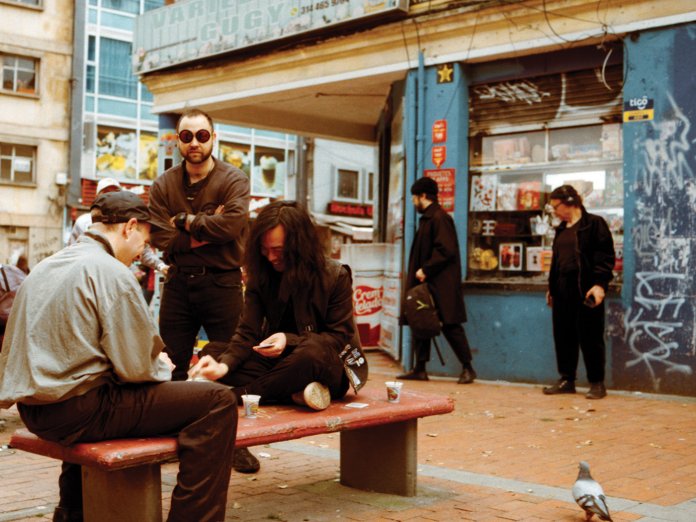A few songs into Unknown Mortal Orchestra’s fifth album, there’s an extraordinary sound. It’s not a musical one, however – at least not in the conventional sense. In the final moments of “The Widow”, a loose-limbed exercise in Headhunters-style jazz-funk, most of the instruments abruptly fall away, leaving only a final series of plaintive piano chords and the twittering of birds outside (a child’s laughter and a few noisy frogs are discernible too). It’s as if a window has been flung open to allow the air and the light in. Since this moment of ordinary magic is generated by a band whose recordings can sometimes feel cloistered to the point of claustrophobia, the effect is startling.
It’s also indicative of the warmth that suffuses V, an album confirming Ruban Nielson’s versatility and imagination, as well as a new willingness to escape the nooks and crannies of his own psyche and engage more fully with the world outside. Just as the marriage of melodic songcraft, emotional frankness and avant-rock mess-thetics on 2015’s Multi-Love marked an artistic and commercial breakthrough for the Auckland-born musician, the new album does the same by embracing a more extroverted disposition. Full of carefully crafted, pleasingly askew songs that evoke the sunniest pop and soft rock of his childhood, along with freewheeling instrumentals that combine the languor of Khruangbin with an edge of psychedelic soul, V brandishes a summery vitality – albeit one that still coexists with the darker aspects of Nielson’s lyrical vision.
One reason for Unknown Mortal Orchestra’s brightened outlook may be Nielson’s decision to move his base of operations from rainy Portland to more inviting climes. An extended visit to California while performing at Coachella in 2019 inspired him to relocate to Palm Springs in the early months of the pandemic. After beginning work on the album with his brother Kody – sprightly yacht-pop marvel “Weekend Run” and the Prince-ly “That Life” were the first songs here to emerge as singles in 2021 – he made a wider effort to get more of his kin together in Hilo, Hawaii. Nielson’s travels back and forth across the Pacific prompted a deeper consideration of his Hawaiian heritage.
That included the musical tradition known as hapa-haole, a hybrid form combining indigenous styles and instruments with the western influences that became ever more pervasive after America’s annexation of the Hawaiian islands at the end of the 19th century. Its influence here manifests in Nielson’s clear affection for the
slack-key guitar style of local players. Beatific songs like “Guilty Pleasures” also share the sun-kissed feel of Hawaiian reggae, a sound originally pioneered by one of Nielson’s uncles.
That said, Nielson ventures beyond travel-brochure ideals about an island paradise. The ugly history and legacy of colonialism are overtly addressed in one of the tracks he created when work on V resumed. In the spare “I Killed Captain Cook”, he imagines himself as one of the islanders who killed the English explorer after his attempt to kidnap Hawaii’s high chief Kalani’õpu’u in 1782. “Keaukaha”, a near-ambient instrumental named after a beach on Hawaii’s south coast, has the same elegiac quality.
Yet for the most part, Nielson’s new surroundings seem to have had a more salubrious effect. With their insistent melodies and irresistible rhythms, “The Garden”, “Guilty Pleasures” and “The Beach” all boast an easy buoyancy rarely achieved since the days of deep-dive soft-rockers like Airplay and Maxus. Besides proving his ability to tap into Prince’s paisley-patterned wavelength circa Around The World In A Day, “Layla” also demonstrates the casual grace Nielson can achieve as a guitarist when he resists the temptation to smear everything with effects.
Songs like “Shin Ramyun” – another beguiling instrumental named after a Korean brand of instant noodles – and “In The Rear View” still have the woozy, frayed-cassette-tape vibe that’s been a component of Unknown Mortal Orchestra since the first spate of home recordings that yielded 2011’s self-titled debut. But when compared to the more clamorous and sometimes combative nature of 2018’s Sex & Food, the clarity and effervescence of much of V can seem revelatory. Likewise, for all the dreams of escape that permeate songs like “Layla” (“Lay low, Layla / Let’s get outta this broken place”) or the painful memories of fading romances and family rancour that surface elsewhere, Nielson sounds like an artist who’s arrived at where he needs to be. All indications suggest the weather there is excellent.


